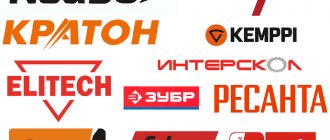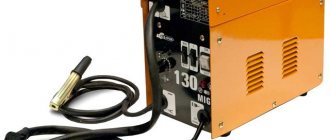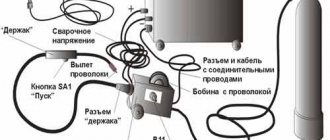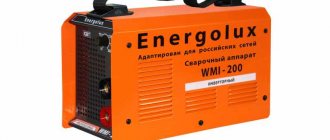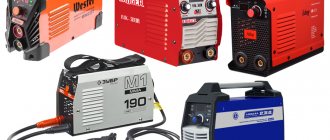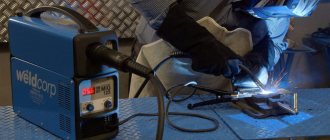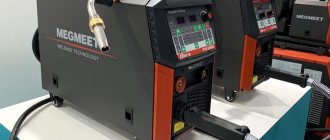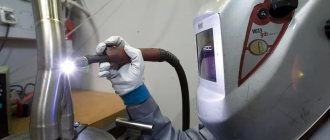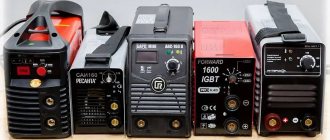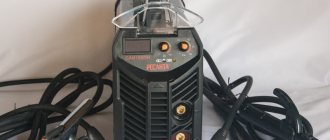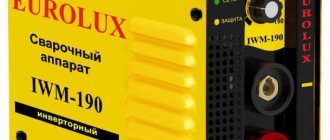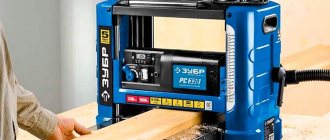There is an opinion that can be considered an axiom for home craftsmen: “Strive to choose the best possible offer.” And if previously the only possible option was a transformer welding machine, which practically did not work at low network voltage, now you have the opportunity to have an unprecedented choice among inverters. They are superior to outdated models in many respects. This includes mobility, light weight, and the ability to carry out welding in field conditions when the network voltage is of very low quality. In this article we present the 16 best welding inverters for home and garden in the price category from 7,000 to 75,000 rubles. All prices are taken from Yandex Market.
Main characteristics of welding inverters:
- Power (rated welding current). This characteristic is indicated in the passport for the device. The rated welding current is the value A at which the inverter (taking into account the recommended load duration, PN%) will operate without shutting down due to overheating. Considering the conditions of the required operation, for example, a rated current of 120A is required, you should choose a device with a rated current of 180A, i.e. Allow a current reserve of about 50%. This will allow you to carry out welding work when the input network voltage is critically reduced and when using cables with a length of over 5 meters.
- Load duration (LO). Characterizes the operation of the welding inverter in intermittent mode.
- Supply voltage range. If the mains voltage has significant deviations from the nominal value, and this often happens outside the city and in holiday villages, then it is considered unstable and you should purchase devices that can operate with voltage surges of 20-30%.
- Additional characteristics that ensure ease of use of the equipment: ARC FORCE (arc force) - arc stabilization;
- HOT START (hot start) - provides simple arc ignition by increasing current loads during start;
- ANTI STICK (anti-stick) - turns off the device in the event of a short circuit, avoiding sticking of the electrode.
Which welding inverter is the best to use?
Before moving on to the TOP of the best inverter devices, let's look at their varieties by design, principle of operation and scope of use.
Inverter for manual arc welding (MMA)
Principle of operation. Inverters for RDS are made in a single housing and are distinguished by compact dimensions within the range of 30x20x15 cm. Most often they weigh 3-6 kg and are convenient for working at heights or along a long structure. The welder simply hangs the machine on his shoulder and moves with it. Inside the inverter there is a step-down transformer, a circuit board with switches and a diode bridge. Receiving 220 or 380 V alternating current from the network, the equipment increases its frequency hundreds of times and converts it to direct current.
MMA inverters are available with two connectors to which the holder and ground cables are connected. The clip with the value “-” clings to the product. A coated electrode is attached to “+”. Closing the contacts leads to the initiation of an electric arc. The distance between the end of the electrode and the surface of the product must be maintained within 2-5 mm so that the rod does not stick. The filler metal fills the weld pool to form a weld. The electrode coating, when melting, releases a gas that protects the molten metal from the external environment.
Diagram of the manual arc welding (MMA) process.
In what case is it better to use. Due to their simplicity and compactness, MMA inverters are often used in the country, in the courtyard of a private house and small workshops. But it works slowly (you need to constantly change electrodes, clean the seams from slag crust), so it is suitable for tasks where the final result and efficiency are a priority, rather than manufacturing time (make your own fence, weld a hinge on a gate, make a greenhouse, etc.) .d.).
Inverter for manual arc welding.
Inverter for semi-automatic welding (MIG/MAG)
Principle of operation. MIG/MAG inverters are available in a single housing or separate housing with a feed mechanism. The wire wound around the bobbin here plays the role of an electrode, closing the circuit to form an electric arc. But since the additive is supplied continuously from the drum, the seams are long and even, without obvious transitions. The welder operates a torch, inside which current, wire and shielding gas are supplied. The latter can be inert (argon, helium) or with active protection (carbon dioxide). The advantage of MIG inverters is the fast speed of seam execution and high quality of connection. The absence of slag crust does not require subsequent cleaning.
Diagram of the semi-automatic welding process (MIG/MAG).
In what case is it better to use. Such equipment is suitable for car body repairs, mass production of barbecues, doors, gates, and containers. But you need to be prepared for additional costs for a gas cylinder.
Inverter for semi-automatic welding.
Inverter for TIG welding
Principle of operation. Inverters for TIG welding are very similar to models for MMA, only they have a built-in gas supply unit and a connector for connecting the torch control connector. Welding is carried out with a non-consumable electrode (usually tungsten with impurities). Thanks to the sharp sharpening and constant arc distance, the seam is narrow and even. The weld pool is protected from the external environment by inert gas (argon, helium) supplied from the nozzle. The joint surface does not require cleaning or machining.
Such inverters can operate on direct or alternating current. In the first case, this makes it possible to weld stainless steel, black steel and cast iron. In the second case, excellent seams are obtained on aluminum and copper.
Diagram of the TIG welding process.
In what case is it better to use. It is practical to buy a TIG inverter for the manufacture of structures made of stainless steel or non-ferrous metals. This is in demand at large and small enterprises in the chemical and food industries, car services (repairing bumper bars on SUVs, welding cracks in the crankcase, cooling units), and in the production of heated towel rails.
Inverter for argon arc welding.
Universal welding inverters
This category of inverters contains equipment that combines several welding methods. For example, there are devices for working with coated electrodes and feeding wire from a reel (MMA + MIG). The body has separate connectors for connecting a semi-automatic burner and an electrode holder.
Such an inverter is in demand for car repairs or the manufacture of metal structures, where a high welding speed is required, but from time to time you need to cut something with electric welding or put a seam in an inconvenient place (it is inconvenient to crawl with a torch, but a thin electrode can be bent and inserted).
There are also MMA+TIG inverters. They may have a full-fledged connector for connecting an argon torch with a button (pressing the button simultaneously starts the supply of gas and voltage), or the TIG torch is attached only optionally. In the second case, you will need a valve model, where gas is supplied by opening the tap, and to ignite the electrode you need to touch it to the surface. This is less convenient and is suitable for periodic welding of stainless steel. When mass-producing products, you need to buy an inverter with separate connectors and a built-in burner. The presence of MMA welding will allow you to weld ferrous metal 10-20 mm thick if necessary.
VyborExperta.ru recommends
Which welding inverter should you choose from the models given in the review? The VyborExperta.ru team recommends taking into account the scope of application, degree of preparation, and the condition of the electrical network in the area of work. We advise you to pay attention to the following models:
- Resanta SAI-190K - for the construction of a country house;
- Wert WIN 190 – for welding in the country;
- Cet MMA is a budget option for the home workshop;
- Start MIG 190 – the choice of a professional welder;
- Bison Master MMA SA-220K – for installation in difficult conditions;
- Fubag IQ 200 – for intensive use in a country house and country house.
All the models presented in our review are worthy of the attention of home craftsmen, but only the most functional and reliable received the title of best in their class.
Simple and reliable BLUEWELD Prestige 186 PRO
The semi-automatic BLUEWELD Prestige 186 PRO is not by chance in the ranking of the best budget welding inverters. It has the ability to operate in two modes - MMA or TIG, and is characterized by simplicity and reliability of operation. But it is more suitable for work that requires MMA mode. Therefore, it is perfect for those specialists who rarely have to resort to TIG welding in practice. Otherwise, you will have to face the problem of low quality seams obtained in this operating mode.
The maximum power of welding equipment is 160 amperes. Under maximum load conditions, it can perform 60% of the cycle. That is, 6 minutes are spent on welding work, and 4 minutes are spent on cooling the power plant. The tool is convenient for specialists with a traveling nature of work, since its weight is only 5 kg.
At first glance, one is struck by the relatively modest functionality of the unit and the not-so-modest price for a budget model, amounting to approximately 14,000 rubles. But there is one important circumstance that explains this paradox. The fact is that the model is assembled in Italy, and high-quality components are used in its production. So, unlike Chinese analogues, the price also includes payment for European quality standards. Judging by user reviews, this is true. The device has good build quality and reliability.
Advantages
- Light weight and dimensions.
- High stability of welding current.
- “Arc Force”, “Hot Start”, “Antistick” function.
- Practicality and ease of use.
The most expensive model in the rating: Torus 200C Super
Difficulties in choosing a purchase option are caused not only by the large assortment of goods, but also by prices. Sometimes they are unacceptably high. Especially when it comes to options capable of performing work in MMA and TIG modes. Such models on store shelves are accompanied by high price tags, and sellers and manufacturers in unison justify them by the additional functionality of the devices they sell.
The exception to this unpleasant rule was the Torus 200C Super welding inverters. They are designed to operate in both modes, generate a welding arc of 200 amperes and cost about 15,000 rubles. The manufacturer declares the possibility of continuous long-term operation even at maximum loads, provided that the metal being welded is not thick. And experienced welders leave positive reviews on various forums about the functionality and reliability of the device.
The model will interest not only beginners, but also experienced craftsmen. It lights the arc easily and keeps it stable throughout the entire cycle. In this case, it does not matter at all which mode is set by the regulator - TIG or MMA.
Advantages
- Light weight and dimensions.
- Resistance to voltage changes - 165-242 V.
- Use of electrodes with a diameter of up to 5 mm.
- D.C.
- PV - 100% at 200A.
- Thermostat and air cooling.
Resanta SAI 190PROF
Another representative of the same brand, the demand for which is not decreasing, but only growing. This is one of the best-selling models in the SAI line. Its performance characteristics are more than sufficient for household equipment, and its relatively low cost makes the installation in demand among different categories of users.
Compact, easy-to-use welding inverter produces pulses with a power of 190 amperes. The main difference, which is highly appreciated by customers, is the ability to perform welding work with a voltage of only 100 volts. It was this technological solution that made it possible to bring the model into the rating category. It is so successful that even the fairly high price for the household segment of 15 thousand rubles did not reduce consumer demand to a critical level. The ability to weld in poor power conditions has become more important to potential buyers.
Advantages
- Light weight.
- Compactness.
- Voltage range 100-260V.
- Operating temperature from -10 to +40 degrees.
- Anti Stick, Hot Start and ARC FORCE functions.
- Shockproof housing.
- Smooth adjustment of welding current.
- Easy ignition.
KRÜGER WIK-250/WIK-300 for practicing welders
The KRÜGER WIK-250 and WIK-300 welding machines belong to a generation of modern inverters designed for experienced professionals. Only they will be able to appreciate all the development capabilities of German engineers. In addition to the traditionally high build quality, they are also endowed with excellent reliability. The devices operate reliably even in conditions of unstable power supply. Users have access to the “Anti-stick”, “Arc Force” and “hot start” functions. Thanks to this, all work can be completed at a decent level.
The operating range of the WIK-250 model ranges from 20 to 250 amperes, which makes it possible to perform the vast majority of welding work. If you need more power, then you should pay attention to a more productive analogue - WIK-300, the upper amperage of which is 300A.
Both models of the famous Kruger brand are based on IGBT transistors. This ensures fine-tuning of the equipment and its uninterrupted operation in almost any conditions. The durable case reliably protects the interior from shock, excess moisture and dust. It would not be amiss to recall that the generally accepted quality standards in Germany apply not only to expensive, but also to products that are affordable to customers. Quality assurance has long been the hallmark of German manufacturers.
Among other advantages of the WIK-250 and WIK-300 welding inverters, it is necessary to highlight their small size. The welder will become an indispensable assistant for specialists with a traveling nature of work. This is also facilitated by the relatively small weight - only 5 kg. The price will also please buyers: 5000-6000 rubles. It is acceptable not only for professionals who earn money by welding, but also for beginners taking their first steps in this field. The maximum configuration should also be emphasized. The price of the offer includes powerful cables, a shoulder strap for easy carrying, a hammer brush and a mask. Among the shortcomings, consumers note only the lack of a transport case.
Advantages
- Current adjustment in the range of 20-250A.
- Easy arc start.
- Stabilization of the welding arc during operation.
- Protection against electrode sticking is provided.
- Automatic against short circuit, current or power overload.
- Automatic power and current control.
MMA welding: what is it?
MMA is called manual arc welding with a covered electrode. This is the simplest method that even beginners can do. The power source is connected to the mains, 2 cables of different polarity for supplying current to the materials being connected.
One cable has a clamp at the end, fixed to the workpiece, the second with a holder at the end is used to fix the electrode. During manual arc welding, the thermal energy of an electric arc is used, which occurs when a simple electrical circuit is closed. Under the thermal influence of the arc, the metal melts and a weld pool is formed. At the moment the flow of electric current stops, the metal cools and crystallizes, thus forming a welded joint.
Equipment for MMA is the simplest, does not require any special additional devices, and its purchase is inexpensive. It is only necessary to set the appropriate current value. The equipment includes (in addition to the welder’s equipment and consumables) the device itself with a wire for connecting to the network and two insulated cables of a suitable cross-section - with a ground clamp and an electrode holder.
How to choose an inverter for a summer house or home?
When thinking about purchasing a welding converter, the buyer first needs to know what technical characteristics to pay attention to. Main selection criteria:
- current strength, on which the maximum diameter of the electrodes depends;
- duration of continuous welding. For household appliances it is about 5–10 minutes;
- sensitivity to voltage drops, if the deviation is no more than 10–15%;
- protection against voltage surges - with high surges reaching 20–30%;
- presence of a protective function against overheating;
- open circuit voltage, which affects how easily the arc will ignite and how stable the discharge will be. The higher the voltage, the better;
- the presence of additional functions, for example, “anti-stick”, “hot start”, “arc force”, a display for easy settings and control of the inverter operation process.
Resanta SAI 220 for the dacha
The well-known Latvian brand has long earned a reputation in the domestic market as a manufacturer of affordable and fairly high-quality welding equipment. Let's consider the main advantages and disadvantages of a particular model. The welding inverter SAI 220 is popular among amateurs and novice welders. Low cost (only 8,000 rubles) plus good assembly and good quality components are the main reasons that make the model in demand.
The maximum that the welder provides is 220 amperes. This is enough to use electrodes with a diameter of up to 5 mm, as well as cut metal of medium thickness. Without a break, he can work 7 minutes out of 10, i.e. It runs for 7 minutes and cools down for 3 minutes. And so on through the cycle. However, the model was nicknamed “dacha” for another reason. It works perfectly with unstable voltage in the power supply network and can withstand fluctuations from 160 to 260 volts.
However, buyers have noted a decline in the build quality of inverters in recent years. Another disadvantage is the demanding equipment. It is undesirable to allow it to become waterlogged or overcooled, as this can lead to rapid failure of the components. Despite such significant disadvantages, SAI 220 remains on the list of the most popular welding machines and rightfully takes its place in the compiled rating.
Budget model FUBAG IR 200
Despite its modest cost (on average about 8 thousand rubles), the inverter “gives out” up to 200 amperes. It is advisable to use it not only for welding, but also for cutting metal workpieces. In work, you can use electrodes with a diameter of up to 5 mm, which makes it possible to perform almost all work on a personal plot or in an apartment. The power unit works well even in conditions of unstable power supply.
Among the additional functionality, users will be able to take advantage of anti-sticking, arc force and hot start. All of them will be useful for both beginners and experienced welders. The equipment's inclusion in the rating list was greatly facilitated by good assembly and high-quality components. There are few disadvantages, but they exist. The most significant is the short period of continuous operation - 4 minutes. After this, you need to let the inverter cool for 6 minutes and you can continue. So the unit is not suitable for commercial use.
Advantages
- Light weight.
- Efficient cooling.
- Good seam quality.
- Powerful welding cables.
MMA VRD 200 from Wester
As opposed to the previous model, the VRD 200 is capable of working without “smoke breaks” in a mode of up to 120 amperes of welding current. In other words, the equipment will be of interest to those who have to work long and often. It is worth considering that this rule does not apply to operations with electrodes with a diameter of 5 mm. In this case, you will have to find time for breaks.
The maximum current is 200A. Additional functions include a standard set typical for most devices of this class: anti-sticking, hot start and arc force. In addition, manufacturers have improved the safety of the design. The terminal voltage is reduced to a minimum level in situations where the inverter is connected to the grid but not in use. And only in case of load the voltage increases sharply to operating parameters.
Based on the operational parameters and cost (approximately 11 thousand rubles), the Wester MMA-VRD 200 can be safely classified as an amateur, but quite reliable and functional model.
